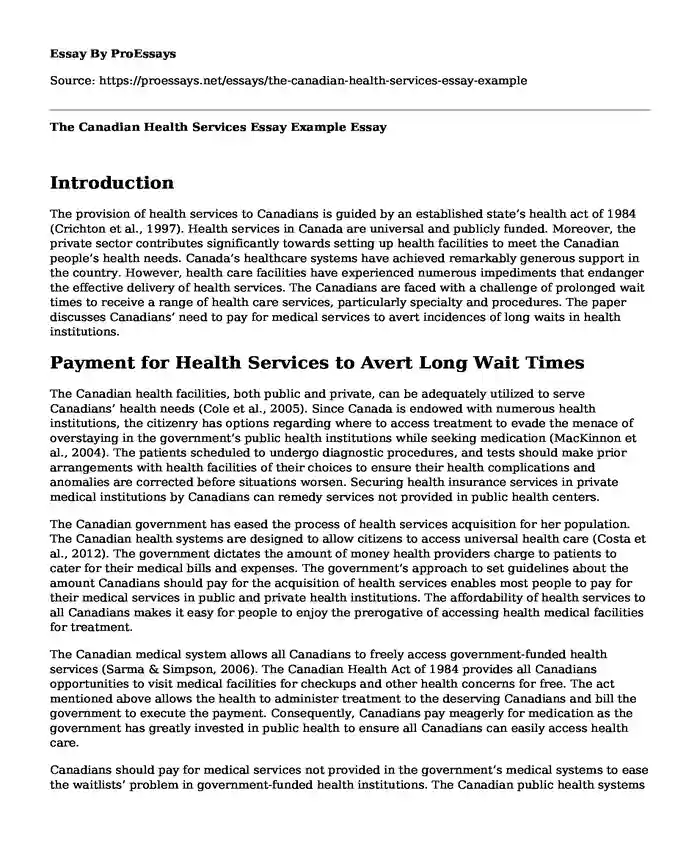Introduction
The provision of health services to Canadians is guided by an established state’s health act of 1984 (Crichton et al., 1997). Health services in Canada are universal and publicly funded. Moreover, the private sector contributes significantly towards setting up health facilities to meet the Canadian people’s health needs. Canada’s healthcare systems have achieved remarkably generous support in the country. However, health care facilities have experienced numerous impediments that endanger the effective delivery of health services. The Canadians are faced with a challenge of prolonged wait times to receive a range of health care services, particularly specialty and procedures. The paper discusses Canadians’ need to pay for medical services to avert incidences of long waits in health institutions.
Payment for Health Services to Avert Long Wait Times
The Canadian health facilities, both public and private, can be adequately utilized to serve Canadians’ health needs (Cole et al., 2005). Since Canada is endowed with numerous health institutions, the citizenry has options regarding where to access treatment to evade the menace of overstaying in the government’s public health institutions while seeking medication (MacKinnon et al., 2004). The patients scheduled to undergo diagnostic procedures, and tests should make prior arrangements with health facilities of their choices to ensure their health complications and anomalies are corrected before situations worsen. Securing health insurance services in private medical institutions by Canadians can remedy services not provided in public health centers.
The Canadian government has eased the process of health services acquisition for her population. The Canadian health systems are designed to allow citizens to access universal health care (Costa et al., 2012). The government dictates the amount of money health providers charge to patients to cater for their medical bills and expenses. The government’s approach to set guidelines about the amount Canadians should pay for the acquisition of health services enables most people to pay for their medical services in public and private health institutions. The affordability of health services to all Canadians makes it easy for people to enjoy the prerogative of accessing health medical facilities for treatment.
The Canadian medical system allows all Canadians to freely access government-funded health services (Sarma & Simpson, 2006). The Canadian Health Act of 1984 provides all Canadians opportunities to visit medical facilities for checkups and other health concerns for free. The act mentioned above allows the health to administer treatment to the deserving Canadians and bill the government to execute the payment. Consequently, Canadians pay meagerly for medication as the government has greatly invested in public health to ensure all Canadians can easily access health care.
Canadians should pay for medical services not provided in the government’s medical systems to ease the waitlists’ problem in government-funded health institutions. The Canadian public health systems have faults whose solution can be found in privately sponsored facilities (Day et al., 2007). One of the discernible flaws is the Canadian government-funded health institutions’ inability to provide all medical services for the people. Consequently, the citizens are forced to seek medical in private facilities where the payment for services rendered is exceptionally high. Therefore, a faction of financially incapacitated Canadians may be incapable of accessing the medical services lacking in government-funded public facilities (Iglehart, 2000). The Canadian government’s inability to incorporate all medical services for the people raises whether Canadian health care is free and universal. Providing health care to the Canadian populace can only be termed as free and universal if it allows for all the services they need.
Conclusion
The Canadian’s universal and free health programs have been lauded globally to ease access to health services to the Canadian population. The country should struggle to reinforce the health systems by incorporating essential health services. Stable health care systems within the Canadian society are critical to sustaining outstanding health for the people needed for the economic prosperity of the country
References
Cole, D. C., Robson, L. S., Lemieux-Charles, L., McGuire, W., Sicotte, C., & Champagne, F. (2005). Quality of working life indicators in Canadian health care organizations: a tool for healthy, health care workplaces?. Occupational Medicine, 55(1), 54-59. https://doi.org/10.1093/occmed/kqi009
Costa, A. P., Poss, J. W., Peirce, T., & Hirdes, J. P. (2012). Acute care inpatients with long-term delayed-discharge: evidence from a Canadian health region. BMC health services research, 12(1), 172. https://doi.org/10.1186/1472-6963-12-172
Crichton, A., Robertson, A., & Gordon, C.(1997). Health care: A community concern?: Developments in the organization of Canadian health services. University of Calgary Press.
Day, B., Langlois, R., Tremblay, M., & Knoppers, B. M. (2007). Canadian Health Measures Survey: ethical, legal, and social issues. Health Reports, 18, 37-51. http://hdl.handle.net/10822/967716
Iglehart, J. K. (2000). Revisiting the Canadian health care system. New England Journal of Medicine, 342(26), 2007-2012. http://gdctn.org/info/HealthCare/Canada%20revisited-%20NEJM%202001.pdf
MacKinnon, N. J., Chow, C., Kennedy, P. L., Persaud, D. D., Metge, C. J., & Sketris, I. (2004, December). Management competencies for Canadian health executives: views from the field. In Healthcare Management Forum, 17(4), 15-20. https://doi.org/10.1016/S0840-4704(10)60624-2
Sarma, S., & Simpson, W. (2006). A microeconometric analysis of Canadian health care utilization. Health economics, 15(3), 219-239. https://doi.org/10.1002/hec.1057
Cite this page
The Canadian Health Services Essay Example. (2024, Jan 05). Retrieved from https://proessays.net/essays/the-canadian-health-services-essay-example
If you are the original author of this essay and no longer wish to have it published on the ProEssays website, please click below to request its removal:
- American Express Campaigns
- Paper Example on Silent Myocardial Infarction
- Comments on Patient's Results: Acute Pulmonary Edema Paper Example
- Essay Sample on The Cherokee Indians
- Gastrointestinal Case Study Paper Example
- Essay Example on Citizens of America: Seek Justice Through State & Federal Courts
- Essay Example on Modern Technology Enhancing Nursing Practice







